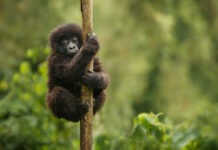The world’s largest fossil spider has been unearthed in Mongolia.
Nephila jurassica sp. nov. dates from the Middle Jurassic, some 165 million years ago. Paul Selden, ChungKun Shih and Dong Ren of the Capital Normal University in Beijing describe the beastie in this week’s Biology Letters.
Although this example is dwarfed by some living spiders – that rock in the picture is only 5 cm long – it is still an impressive specimen. It extends the fossil record of the Nephila genus back another 130 million years from previous knowledge.
“It is likely that N. jurassica wove large, golden orb webs to catch medium- to large-sized insects in the Daohugou forests,” write the researchers. “Predation by these spiders would have played an important role in the natural selection of contemporaneous insects.”
Selden, who is also director of the Paleontological Institute at the University of Kansas, is something of an expert on fossil spiders. Not only has he debunked a previous contender for the ‘largest fossil spider’ crown, he has also featured on these very pages with another gorgeous fossil arachnid (Amazing ancient arachnids – 9 February, 2010) and featured on Nature’s cover.
Source: Nature

















